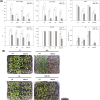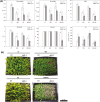ABA is required for the accumulation of APX1 and MBF1c during a combination of water deficit and heat stress
- PMID: 27497287
- PMCID: PMC5049388
- DOI: 10.1093/jxb/erw299
ABA is required for the accumulation of APX1 and MBF1c during a combination of water deficit and heat stress
Abstract
Abscisic acid (ABA) plays a key role in plant acclimation to abiotic stress. Although recent studies suggested that ABA could also be important for plant acclimation to a combination of abiotic stresses, its role in this response is currently unknown. Here we studied the response of mutants impaired in ABA signalling (abi1-1) and biosynthesis (aba1-1) to a combination of water deficit and heat stress. Both mutants displayed reduced growth, biomass, and survival when subjected to stress combination. Focusing on abi1-1, we found that although its stomata had an impaired response to water deficit, remaining significantly more open than wild type, its stomatal aperture was surprisingly reduced when subjected to the stress combination. Stomatal closure during stress combination in abi1-1 was accompanied by higher levels of H2O2 in leaves, suggesting that H2O2 might play a role in this response. In contrast to the almost wild-type stomatal closure phenotype of abi1-1 during stress combination, the accumulation of ascorbate peroxidase 1 and multiprotein bridging factor 1c proteins, required for acclimation to a combination of water deficit and heat stress, was significantly reduced in abi1-1 Our findings reveal a key function for ABA in regulating the accumulation of essential proteins during a combination of water deficit and heat stress.
Keywords: aba1-1; abi1-1; APX1; MBF1c; abiotic stress; abscisic acid; acclimation; heat stress; stomata; stress combination; water deficit..
© The Author 2016. Published by Oxford University Press on behalf of the Society for Experimental Biology.
Figures








Similar articles
-
Enhancement of abscisic acid sensitivity and reduction of water consumption in Arabidopsis by combined inactivation of the protein phosphatases type 2C ABI1 and HAB1.Plant Physiol. 2006 Aug;141(4):1389-99. doi: 10.1104/pp.106.081018. Epub 2006 Jun 23. Plant Physiol. 2006. PMID: 16798945 Free PMC article.
-
F-box protein DOR functions as a novel inhibitory factor for abscisic acid-induced stomatal closure under drought stress in Arabidopsis,Plant Physiol. 2008 Dec;148(4):2121-33. doi: 10.1104/pp.108.126912. Epub 2008 Oct 3. Plant Physiol. 2008. PMID: 18835996 Free PMC article.
-
RAP2.6L overexpression delays waterlogging induced premature senescence by increasing stomatal closure more than antioxidant enzyme activity.Plant Mol Biol. 2012 Aug;79(6):609-22. doi: 10.1007/s11103-012-9936-8. Epub 2012 Jun 4. Plant Mol Biol. 2012. PMID: 22661072
-
Nitric oxide, stomatal closure, and abiotic stress.J Exp Bot. 2008;59(2):165-76. doi: 10.1093/jxb/erm293. J Exp Bot. 2008. PMID: 18332225 Review.
-
Function of ABA in Stomatal Defense against Biotic and Drought Stresses.Int J Mol Sci. 2015 Jul 6;16(7):15251-70. doi: 10.3390/ijms160715251. Int J Mol Sci. 2015. PMID: 26154766 Free PMC article. Review.
Cited by
-
The Role of the Plant Antioxidant System in Drought Tolerance.Antioxidants (Basel). 2019 Apr 8;8(4):94. doi: 10.3390/antiox8040094. Antioxidants (Basel). 2019. PMID: 30965652 Free PMC article. Review.
-
Penetration of foliar-applied Zn and its impact on apple plant nutrition status: in vivo evaluation by synchrotron-based X-ray fluorescence microscopy.Hortic Res. 2020 Sep 1;7:147. doi: 10.1038/s41438-020-00369-y. eCollection 2020. Hortic Res. 2020. PMID: 32922819 Free PMC article.
-
Omics analyses in citrus reveal a possible role of RNA translation pathways and Unfolded Protein Response regulators in the tolerance to combined drought, high irradiance, and heat stress.Hortic Res. 2023 May 19;10(7):uhad107. doi: 10.1093/hr/uhad107. eCollection 2023 Jul. Hortic Res. 2023. PMID: 37577403 Free PMC article.
-
The Cluster Transfer Function of AtNEET Supports the Ferredoxin-Thioredoxin Network of Plant Cells.Antioxidants (Basel). 2022 Aug 6;11(8):1533. doi: 10.3390/antiox11081533. Antioxidants (Basel). 2022. PMID: 36009251 Free PMC article.
-
Effects of Combined Abiotic Stresses Related to Climate Change on Root Growth in Crops.Front Plant Sci. 2022 Jul 1;13:918537. doi: 10.3389/fpls.2022.918537. eCollection 2022. Front Plant Sci. 2022. PMID: 35845642 Free PMC article. Review.
References
-
- Arce DP, Godoy AV, Tsuda K, Yamazaki K, Valle EM, Iglesias MJ, Di Mauro MF, Casalongué CA. 2010. The analysis of an Arabidopsis triple knock-down mutant reveals functions for MBF1 genes under oxidative stress conditions. Journal of Plant Physiology 167, 194–200. - PubMed
-
- Assmann SM, Snyder JA, Lee YJ. 2000. ABA-deficient (aba1) and ABA-insensitive (abi1-1, abi2-1) mutants of Arabidopsis have a wild-type stomatal response to humidity. Plant, Cell and Environment 23, 387–395.
-
- Bartels D, Sunkar R. 2005. Drought and salt tolerance in plants. Critical Reviews in Plant Sciences 24, 23–58.
-
- Boeck HJ De, Bassin S, Verlinden M, Zeiter M, Hiltbrunner E. 2015. Simulated heat waves affected alpine grassland only in combination with drought. New Phytologist 209, 531–541. - PubMed
Publication types
MeSH terms
Substances
LinkOut - more resources
Full Text Sources
Other Literature Sources

